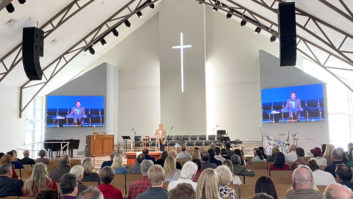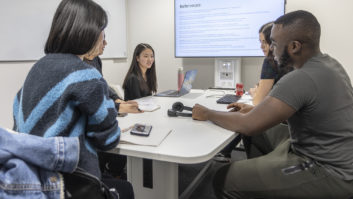
In the first part of this education feature we outlined how digital learning has taken effect in HE. Here Ian McMurray looks at the technology enabling this new paradigm.
It seems that lecture theatres, IWBs and so on are still relevant – but what are the technologies that are enabling the move towards digital learning?
First and foremost, it seems that AVoIP is key. “AV over IP has introduced a whole new level of capabilities for higher education,” claims Lee Denton, education specialist at Visavvi. “The ability to dynamically change the way spaces are configured and can be merged to create multi-functional environments to suit capacity opens up so many possibilities for optimising space and resource utilisation.”
“The distribution of audiovisual signals over the network with AV over IP devices to create flexible videowalls, multi-display classrooms and breakout spaces, is the state of the art in higher education,” agrees Spiros Andreou, service delivery manager at CDEC, who also notes the importance of display-sharing devices and collaborative distance learning/remote participation tools.
“AV over IP is probably the leading product and the success with that has led to it being expanded to traditional teaching spaces to create a connected education establishment,” adds Phil Waterhouse, business development manager for TIG. “This has meant teaching larger groups in more spaces from one room and having interaction from more students.
You may also be interested in:
Andy Truswell, systems integration manager at Pure AV, sounds a note of caution: the most influential technology depends entirely on your point of view. “When it comes to state of the art, what qualifies is very much in the eye of the beholder,” he says. “An AV manager might think of AV over IP and the flexible delivery of content it enables – but to a student, it could be to log in and pull up the lecture they’ve missed, or the academic in their office conferring with research partners might think it’s the all in one soundbar and webcam in their office that enables them to collaborate with anyone, anywhere.”
“Ease-of-use is critical for higher education installations where, even more than in an office, the people using the system will have different exposure to technology”
Dana Corey, Avocor
Dana Corey, GM/VP of sales at Avocor, notes the rise in popularity of sophisticated large interactive displays as a key enabler for digital learning, is also cautious – but for a different reason.
Easy to integrate
“What has become clear in the last couple of years is that, while new features and technology are interesting for colleges and universities, the most important factor is that the technology is intuitive and easy to use, and that it works with the technology and platforms that students and faculty already use,” he believes. “Ease-of-use is critical for higher education installations where, even more than in an office, the people using the system will have different exposure to technology, preferred platforms, and levels of tech savvy.”
Having cited AVoIP as an important facilitator of the new learning paradigm, TIG’s Waterhouse believes he knows which is the next most influential. “The second biggest growth has been BYOD,” he says. “This gives the student the ability to connect their device to the teaching space and deliver information that would ordinarily need to be emailed to the lecturer or transferred to a storage device. This ease of use has created a better flow to the class.”
The theory of BYOD makes perfect sense, just as it does in the corporate environment. The practical reality, however, seems to be less straightforward.
“Many institutions have installed wireless BYOD tools to allow presentation to a display without needing to plug in a cable in smaller rooms,” says CDEC’s Andreou. “However, there are very few campus rollouts of BYOD technologies being actively used to deliver digital learning and most deployments are confined to proof of concept rooms or specialist learning zones.”
“For many universities, the issues around BYOD are traceability,” he adds. “Some universities have IT restrictions on eduroam being able to identify all users of the WiFi – so unless there is a point of log on, many products fall short of requirements.”
eduroam
eduroam is an international roaming service for users in research, higher education and further education. It is designed to provide researchers, teachers, and students easy and secure network access when visiting an institution other than their own. It is available in over 100 countries worldwide at tens of thousands of locations.
Manufacturers challenged
Waterhouse sees a similar scenario. “Problems arise when the WiFi offered to the students is eduroam – and the corporate LAN is where the device sits,” he explains. “Manufacturers are challenged to make both meet to enable the student to stream and send info to that device even though they are outside of the corporate LAN. Some manufacturers like Crestron have managed this and, working with the universities, have shown them how to create a secure yet effective BYOD environment.”
It’s not all ‘doom and gloom’, however, as Pure AV’s Truswell points out. “The capability for BYOD connection is pretty much a standard now in the spaces we design and install for higher education,” he discloses. “An excellent and consistent GUI design, whether driven by the university or integrator, is essential to ensure a trouble-free experience for the room user.”
“At the University of Liverpool,” Truswell goes on, “the adoption of a consistent user interface incorporating BYOD, across formal and informal learning spaces and within social study areas has proven hugely successful. It has resulted in improved student ratings and enabled students to move seamlessly between formal group teaching, independent and group-based study; the ability to use their own devices and to access reliable WiFi has been a vital component of that experience.”
www.avocor.com
www.cdec.co.uk
www.pureav.co.uk
www.tig.eu
www.visavvi.com







